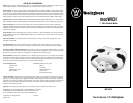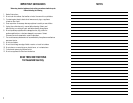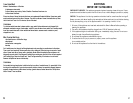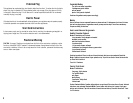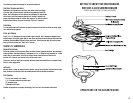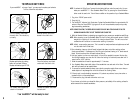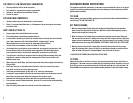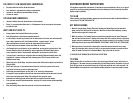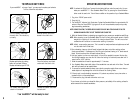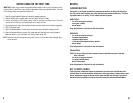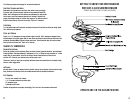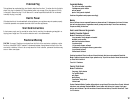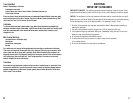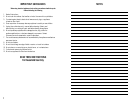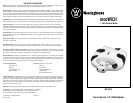
8
7
FOR LOW-FAT, LOW CHOLESTEROL SANDWICHES
• All recipes will work with thin-sliced diet breads.
• Don't add butter, mayonnaise or dressings to sandwiches.
• Use low-fat, low-cholesterol spreads instead of butter.
• Use low-fat cheese.
FOR HIGH-FIBER SANDWICHES
• Instead of white breads, use whole-wheat or oat bran breads.
• Blend 1/4-cup crushed bran flakes into 1 or 2 tablespoons of butter or margarine, then spread
on inside of bread.
HINTS FOR BEST RESULTS
• Always preheat the Sandwich Maker before each use.
• Have all ingredients at hand before preparing sandwich.
• A wide variety of breads may be used, such as whole wheat, fruit breads, and white bread. Be
sure to select breads that will fit the Sandwich Maker —approximately 4” square.
(Most presliced loaves of bread found in the supermarket will be sufficient.)
• For best results, we recommend to butter the outside of the bread.
• Use flavored butters to add interest to your sandwiches, such as garlic or parsley butter. (See
Flavored Butters section in this manual for recipe suggestions.) With plain fillings such as
meats, spread the inside of the bread with mayonnaise, tomato sauce, or pickle relish.
• If you prefer not to use butter or margarine, clean the Cooking Plates occasionally with a little
vegetable oil to prevent sticking and make cleaning easier. Rub off excess oil with a soft,
absorbent paper towel.
• When using soft or liquid fillings, use thicker-sliced breads. Bread can be slightly toasted before
filling is added.
• Most fresh fruits give off juice when heated. Instead of fresh fruits, canned fruits can be
used; drain fruit and pat dry with a clean paper towel.
• Avoid using processed cheeses, as they tend to "run" under high tem-peratures.
• A teaspoon of sugar sprinkled on the buttered side makes toasted sand-wiches more crisp and
adds flavor when using sweet fillings. Serve desserts with custard or cream.
• Remember that whole grain and sweet breads will toast quicker than white breads.
• After you have removed finished sandwiches, close the Lid to retain the heat while assembling
more sandwiches.
• Wipe the Cooking Plates clean after each use to avoid food contami-nation.
USER MAINTENANCE INSTRUCTIONS
This appliance requires little maintenance. It contains no user serviceable parts. Do not try to repair it
yourself. Any servicing requiring disassembly other than cleaning must be performed by a qualified
appliance repair technician.
TO CLEAN
Before cleaning your Sandwich Maker, unplug from the wall outlet and allow the Sandwich Maker to
cool until warm. THE UNIT SHOULD NOT BE
HOT WHEN CLEANING.
1. Wipe the triangle-shaped Cooking Plates and the Diagonal Cooking Edges with an absorbent
paper towel or cloth while the unit is still warm. When the unit has cooled completely, you may
wipe the surface again with a damp cloth.
2. While the surface of the Cooking Plates are coated with a nonstick material, some fillings may
leak and cook onto the surface. If rubbing with a damp cloth fails to remove the burnt-on food, we
suggest you pour a small amount of soda water onto the surface and let it sit overnight. The food
should wipe clean in the morning. NEVER IMMERSE THIS PRODUCT IN WATER OR ANY OTHER LIQUID!
3. Wipe the exterior of the unit with a damp cloth or towel that has been rinsed in warm, soapy
water. Dry thoroughly with a clean, soft cloth. Do not use abrasive cleansers or utensils to clean
either the inside or outside of this Sandwich Maker. They will scratch the surface.
4. CAUTION: DO NOT IMMERSE IN WATER OR ANY OTHER LIQUID.
TO STORE
Unplug unit and allow to cool. Store in its box or in a clean, dry place. Never store it while it is hot or
still plugged in. The power cord may be wound using the Cord Storage area on the bottom of the unit.
Do not put any stress on cord where it enters unit, as this could cause the cord to fray and break. The
Sandwich Maker can be placed in a vertical position (handles pointed up) for neat and compact storage.



